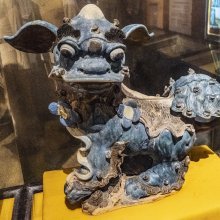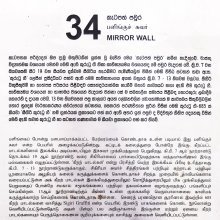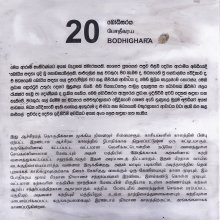Vanna, Vaṇṇa, Vañña: 11 definitions
Introduction:
Vanna means something in Buddhism, Pali, Hinduism, Sanskrit, Jainism, Prakrit. If you want to know the exact meaning, history, etymology or English translation of this term then check out the descriptions on this page. Add your comment or reference to a book if you want to contribute to this summary article.
Images (photo gallery)
In Buddhism
Theravada (major branch of Buddhism)
Source: Pali Kanon: Pali Proper NamesBelonging to the Vanni.
Source: Journey to Nibbana: Patthana DhamaColor;
Source: Pali Kanon: Introducing Buddhist Abhidhammalit: 'colour'; Property of matter (rupa).
Theravāda is a major branch of Buddhism having the the Pali canon (tipitaka) as their canonical literature, which includes the vinaya-pitaka (monastic rules), the sutta-pitaka (Buddhist sermons) and the abhidhamma-pitaka (philosophy and psychology).
Languages of India and abroad
Pali-English dictionary
Source: BuddhaSasana: Concise Pali-English Dictionaryvaṇṇa : (m.) colour; appearance; colour of the skin; sort; caste; a letter; quality.
Source: Sutta: The Pali Text Society's Pali-English DictionaryVaṇṇa, (cp. Vedic varṇa, of vṛ: see vuṇāti. Customary definition as “vaṇṇane” at Dhtp 572) appearance etc. (lit. “cover, coating”). There is a considerable fluctuation of meaning, especially between meanings 2, 3, 4. One may group as follows.—1. colour Sn. 447 (meda°); S. V, 216 (chavi° of the skin); A. III, 324 (saṅkha°); Th. 1, 13 (nīl’abbha°); Vv 4510 (danta°=ivory white); Pv IV. 39; DhA. II, 3 (aruṇa°); SnA 319 (chavi°); VvA. 2 (vicitta°); PvA. 215. Six colours are usually enumerated as vaṇṇā, viz. nīla pīta lohitaka odāta mañjeṭṭha pabhassara Ps. I, 126; cp. the 6 colours under rūpa at Dhs. 617 (where kāḷaka for pabbassara); J. I, 12 (chabbaṇṇa-buddha-rasmiyo). Groups of five see under pañca 3 (cp. J. I, 222).—dubbaṇṇa of bad colour, ugly S. I, 94; A. V, 61; Ud. 76; Sn. 426; It. 99; Pug. 33; VvA. 9; PvA. 32, 68. Opp. suvaṇṇa of beautiful colour, lovely A. V, 61; It. 99. Also as term for “silver. ” — As t. t. in descriptions or analyses (perhaps better in meaning “appearance”) in Abl. vaṇṇato by colour, with saṇṭhānato and others: Vism. 184 (“kāḷa vā odāta vā maṅguracchavi vā”), 243=VbhA. 225; Nett 27.—2. appearance S. I, 115 (kassaka-vaṇṇaṃ abhinimminitvā); J. I, 84 (id. with māṇavaka°); Pv. II, 110 (=chavi-vaṇṇa PvA. 71); III, 32 (kanakassa sannibha); VvA. 16; cp. °dhātu.—3. lustre, splendour (cp. next meaning) D. III, 143 (suvaṇṇa°, or=1); Pv. II, 962 (na koci devo vaṇṇena sambuddhaṃ atirocati); III, 91 (suriya°); Vv 291 (=sarīr’obhāsa VvA. 122); PvA. 10 (suvaṇṇa°), 44.—4. beauty (cp. vaṇṇavant) D. II, 220 (abhikkanta°); M. I, 142 (id.); D. III, 68 (āyu+); Pv. II, 910 (=rūpa-sampatti PvA. 117). Sometimes combined with other ideals, as (in set of 5): āyu, sukha, yasa, sagga A. III, 47; or āyu, yasa, sukha, ādhipacca J. IV, 275, or (4): āyu, sukha, bala A. III, 63.—5. expression, look, specified as mukha°, e.g. S. III, 2, 235; IV, 275 sq.; A. V, 342; Pv III, 91; PvA. 122. ‹-› 6. colour of skin, appearance of body, complexion M. II, 32 (parama), 84 (seṭṭha); A. III, 33 (dibba); IV, 396 (id.); Sn. 610 (doubtful, more likely because of its combination with sara to below 8!), 686 (anoma°); Vism. 422 (evaṃ°=odato vā sāmo vā). Cp. °pokkharatā. ‹-› In special sense applied as distinguishing mark of race or species, thus also constituting a mark of class (caste) distinction & translatable as “(social) grade, rank, caste” (see on term Dial. I. 27, 99 sq.; cp. Vedic ārya varṇa and dāsa varṇa RV II. 12, 9; III, 34, 9: see Zimmer, Altind. Leben 113 and in greater detail Macdonell & Keith, Vedic Index II. 247 sq.). The customary enumeration is of 4 such grades, viz. khattiyā brāhmaṇā vessā suddā Vin. II, 239; A. IV, 202; M. II, 128, but cp. Dial. I. 99 sq.—See also Vin. IV, 243 (here applied as general term of “grade” to the alms-bowls: tayo pattassa vaṇṇā, viz. ukkaṭṭha, majjhima, omaka; cp. below 7); D. I, 13, 91; J. VI, 334; Miln. 225 (khattiya°, brāhmaṇa°).—7. kind, sort Miln. 128 (nānā°), cp. Vin. IV, 243, as mentioned under 6.—8. timbre (i.e. appearance) of voice, contrasted to sara intonation, accent; may occasionally be taken as “vowel. ” See A. I, 229 (+sara); IV, 307 (id.); Sn. 610 (id. but may mean “colour of skin”: see 6), 1132 (giraṃ vaṇṇ’upasaṃhitaṃ, better than meaning “comment”); Miln. 340 (+sara). ‹-› 9. constitution, likeness, property; adj. (-°) “like”: aggi° like fire Pv III, 66 (=aggi-sadisa PvA. 203).—10. (“good impression”) praise DhA. I, 115 (magga°); usually combined and contrasted with avaṇṇa blame, e.g. D. I, 1, 117, 174; A. I, 89; II, 3; III, 264; IV, 179, 345; DA. I, 37.—11. reason (“outward appearance”) S. I, 206 (=kāraṇa K. S. I. 320); Vv 846 (=kāraṇa VvA. 336); Pv IV. 16 (id. PvA. 220); IV, 148.

Pali is the language of the Tipiṭaka, which is the sacred canon of Theravāda Buddhism and contains much of the Buddha’s speech. Closeley related to Sanskrit, both languages are used interchangeably between religions.
Sanskrit dictionary
Source: DDSA: The practical Sanskrit-English dictionaryVanna (वन्न).—[Uṇādi-sūtra 2.28] A co-partner.
Derivable forms: vannaḥ (वन्नः).
Source: Cologne Digital Sanskrit Dictionaries: Shabda-Sagara Sanskrit-English DictionaryVanna (वन्न).—m.
(-nnaḥ) A co-partner, a co-heir, &c. E. vat to ask, ran Unadi aff.
Source: Cologne Digital Sanskrit Dictionaries: Monier-Williams Sanskrit-English DictionaryVannā (वन्ना):—f. Name of a woman, [Catalogue(s)]
[Sanskrit to German]
Sanskrit, also spelled संस्कृतम् (saṃskṛtam), is an ancient language of India commonly seen as the grandmother of the Indo-European language family (even English!). Closely allied with Prakrit and Pali, Sanskrit is more exhaustive in both grammar and terms and has the most extensive collection of literature in the world, greatly surpassing its sister-languages Greek and Latin.
Prakrit-English dictionary
Source: DDSA: Paia-sadda-mahannavo; a comprehensive Prakrit Hindi dictionary1) Vaṇṇa (वण्ण) in the Prakrit language is related to the Sanskrit word: Varṇa.
2) Vaṇṇa (वण्ण) also relates to the Sanskrit word: Varṇa.
3) Vaṇṇa (वण्ण) also relates to the Sanskrit word: Varṇa.
Prakrit is an ancient language closely associated with both Pali and Sanskrit. Jain literature is often composed in this language or sub-dialects, such as the Agamas and their commentaries which are written in Ardhamagadhi and Maharashtri Prakrit. The earliest extant texts can be dated to as early as the 4th century BCE although core portions might be older.
Kannada-English dictionary
Source: Alar: Kannada-English corpusVaṇṇa (ವಣ್ಣ):—
1) [noun] the sensation resulting from stimulation of the retina of the eye by light waves of certain lengths; colour.
2) [noun] the colour that resembles blod; red.
3) [noun] a pigment suspended in a liquid medium and applied with or as with a brush, roller, etc. as a protective or decorative coating to various surfaces or to canvas or other materials in producing a work of art; a paint.
4) [noun] a picture painted on a canvas, paper, etc. applying paints; a painting.
5) [noun] any coloured cloth or clothing.
6) [noun] a colourful flower.
7) [noun] a sort; a variety; a class; a kind.
8) [noun] the original form or state of being.
9) [noun] the quality of a thing that attracts; beauty.
10) [noun] brightness; lustre; shininess.
11) [noun] pretentious behaviour or speech; pretension; hypocrisy.
12) [noun] a song in praise of.
13) [noun] the power to do something, grasp immediately and comprehensively, etc.; mental ability.
14) [noun] a person whose achievement or merit excels another or others.
15) [noun] purity of gold, silver (as expressed with the unit 'carat').
16) [noun] that which is apt, appropriate.
17) [noun] any of the four major classes (brāhmaṇa, kṣatriya, vaiśya and śudra) of old Hindu society.
18) [noun] the quality of being pleasant to the ears; melody.
19) [noun] a group, faction, clan.
Kannada is a Dravidian language (as opposed to the Indo-European language family) mainly spoken in the southwestern region of India.
See also (Relevant definitions)
Starts with (+57): Vanna Sutta, Vanna-cuvaiamutam, Vannaavaram, Vannaavarike, Vannabhu, Vannabhuta, Vannabodhana, Vannacaram, Vannacastiram, Vannada, Vannadada, Vannadasaka, Vannadasi, Vannadhatu, Vannaga, Vannaka, Vannakam, Vannakaraka, Vannakasina, Vannakavottalicai.
Ends with (+126): Abbhuvavanna, Abhiavanna, Abhiyavanna, Accavanna, Aivanna, Ajbhovavanna, Ajbhuvavanna, Ajualavanna, Alivanna, Anekavanna, Anjanavanna, Anomavanna, Anupavanna, Aradivanna, Arunavanna, Aruvanna, Asavanna, Asvanna, Atipravanna, Atthavanna.
Full-text (+173): Vannakkulippu, Vannamakal, Pon-vannakarilai, Malai-vannakurinci, Vannattaru, Vanna-cuvaiamutam, Vannanir, Cheriya-ela-vanna-toli, Dubbaṇṇa, Vannacastiram, Vannakkal, Duratta, Natiru, Pon-vannamin, Kilivannam, Vannappura, Aruvaiyar, Varna, Vannakkunippu, Nibha.
Relevant text
Search found 25 books and stories containing Vanna, Vaṇṇa, Vañña, Vannā; (plurals include: Vannas, Vaṇṇas, Vaññas, Vannās). You can also click to the full overview containing English textual excerpts. Below are direct links for the most relevant articles:
Bihar and Eastern Uttar Pradesh (early history) (by Prakash Narayan)
Vanna (social identification) < [Chapter 4 - Social Process, Structures and Reformations]
Stratification Outside the Sangha/Monastic fourwalls < [Chapter 4 - Social Process, Structures and Reformations]
Terms of Categorization < [Chapter 4 - Social Process, Structures and Reformations]
Tiruvaymoli (Thiruvaimozhi): English translation (by S. Satyamurthi Ayyangar)
Pasuram 2.7.13 < [Section 7 - Seventh Tiruvaymoli (kecavan tamar)]
Pasuram 5.10.5 < [Section 10 - Tenth Tiruvaymoli (Piranta arum)]
Pasuram 7.8.11 < [Section 8 - Eighth Tiruvaymoli (Maya! Vamanane!)]
The Great Chronicle of Buddhas (by Ven. Mingun Sayadaw)
Sakka’s Question (1): on envy (issā) and stinginess (macchariya) < [Chapter 39 - How the Āṭānāṭiya Paritta came to be Taught]
Part 3 - King Suddhodāna’s invitation < [Chapter 16 - The arrival of Upatissa and Kolita]
Visuddhimagga (the pah of purification) (by Ñāṇamoli Bhikkhu)
The Blue Kasiṇa < [Chapter V - The Remaining Kasiṇas (Sesa-kasiṇa-niddesa)]
The Buddha (by Piyadassi Thera)
Bhagavati-sutra (Viyaha-pannatti) (by K. C. Lalwani)



